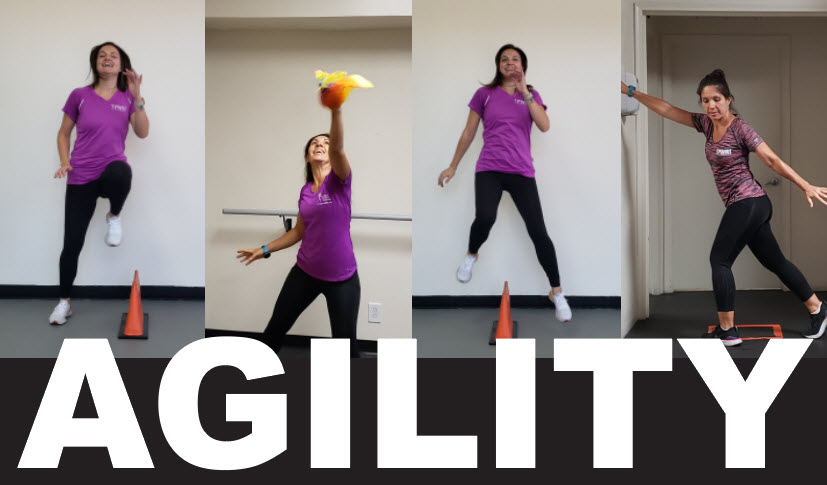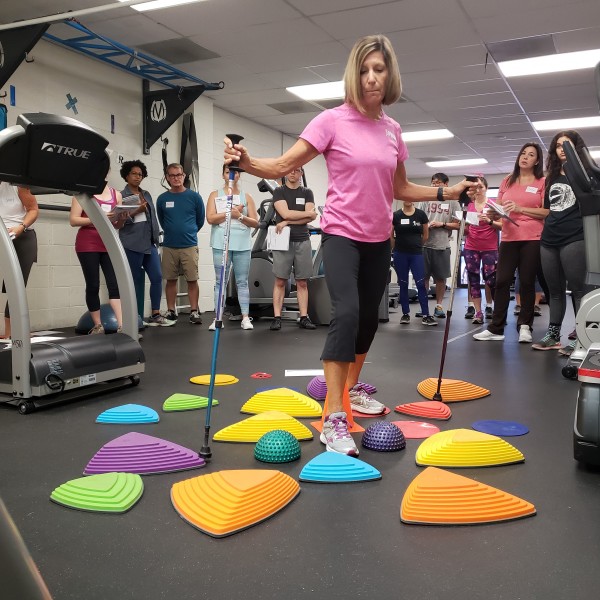
Agility – the ability to start, stop and change direction
While exercise has been hailed as a new therapeutic intervention in Parkinsons Disease, its efficacy depends on the way it is prescribed and implemented! This requires applying the principles of exercise and sports science to persons with Parkinson disease. One of those principles is called “specificity” of training. Read more to find out how we focus on specificity of training in our new release on “Agility”. Discover how you can train like an athlete and make function a sport!
Our Agility Guided Plans
are available to begin today!
Train like an Athlete. Make Function a Sport!
Agility is the ability to start and stop and change direction (or position) quickly and accurately1. Agility requires a foundation of strength, balance and coordination --- making it a multimodal approach to fitness2 --- but it is more than just a physical skill. The ability to “be agile” requires that we make rapid whole-body movements, at the last minute, in response to signals (e.g., instructions) and cues (e.g., targets) from the environment. Even when we are distracted or multi-tasking! Therefore, the focus of agility training is to improve the mind–body connection necessary to carry out rapid complex tasks1. With practice you will learn to process and respond to environmental stimuli faster with more accuracy, and you will reduce the duration of time needed to perform the movement. Recently, this multimodal motor-cognitive training approach to exercise has been described and shown to benefit persons with PD and older healthy adults3-8. It is also a time efficient alternative for exercise training if you have other things you want to do with your day!
Agility is typically associated with sports, martial arts, and dance (Table 1)1,9-12. If you are participating in sports training like football, you need to learn to anticipate and respond to relevant cues related to movement of an opponent approaching, or a teammate preparing to pass a ball. If you are participating in tango, you need to learn to anticipate your partners next movement to be ready to step with the correct leg while matching the rhythm of the music. These are examples of training that mimics the demands of the task. This is called specificity of training and it is one of the major principles of an exercise prescription9!

But what if you have PD and your exercise goal is to “put off the loss of mobility and function? Can you be proactive and sustain or retrain your ability to navigate and function in complex environments? YES
YES. This type of task-specific agility training plays an integral role in rehabilitation for person with Parkinson disease13. The motor and cognitive symptoms of PD interfere the most with your ability to navigate and function in complex environments. If you have early or mild PD, you may only notice the constraints to movement when performing complex coordination in challenging conditions. For example, walking fast in an unfamiliar or cluttered environment while talking to your colleague, or worrying about your next meeting with your boss! As the disease progresses, the loss of mobility and function is inevitable. That is why, just like an athlete, you need to train the mind-body connections that mimic the demands of everyday life to delay disability -- and to sustain or improve mobility and function. In physical and occupational therapy, we call this type of agility training - Functional Mobility14! In fitness, it is often referred to as functional fitness or functional agility!
One of the greatest challenges to Agility
One of the greatest challenges to agility training (and the place to start) is in overcoming the symptom of bradykinesia. This requires acceleration, the ability to exert high attentional effort to produce big and fast whole-body movements over and over again13. It is hard to be agile if you can’t accelerate and move your whole body rapidly! Even if you have early PD and think you don’t have an acceleration problem, then you need to train in more complex conditions that further challenge coordination patterns, strength, balance, predictability and multitasking. The good news is that the training of acceleration has double the rewards......as the process of moving bigger and faster especially in multiple directions, also retrains your ability to anticipate the need to “brake” – to quickly recover your balance to prevent a fall13.
Our focus for the Agility release
For this release (pre-recorded and LIVE classes), we are primarily focusing on this one aspect of agility, whole-body acceleration for reaching and stepping. You will practice rapid multidirectional whole-body movements in different postures, while moving overground (e.g., scooting, crawling, walking) and while transitioning up and down (e.g., floor to stand, all 4’s to side sit, sit to stand). To maintain physical effort and cognitive engagement, the instructors will progressive the challenge by varying the predictability of directions or position, increasing balance, speed or repetition requirements, and by adding resistance or secondary tasks!
If you are fit and newly dx with PD
If you are fit and newly dx with PD; or if you have a preference for a particular sport, agility training is an efficient, multimodal type of practice (balance, strength, coordination) that can be proactive. But you still need to integrate those skills into everyday life. Make sure you check out this release, try a PWR!Moves class, and make an appointment with a PWR!Moves Therapist to give you a task-specific functional agility HEP to meet your mobility and functional goals.
If you are sedentary and deconditioned
If you are sedentary and deconditioned, don’t live to exercise, or simply want to improve your everyday movements and ability to participate in things you like to do – then you may benefit more from one of our functional agility classes like PWR!Circuit, PWR!HIIT and PWR!Moves that progress the environmental and cognitive challenge of the class to be more representative of real-life!
If you are worried about your agility,
please contact us to set up a Wellness Consultation.
Agility for Sports and Fitness
- Martial arts for self-defense (e.g., kickboxing, taekwondo, karate, fencing)
- Sports-specific (e.g., pickleball, soccer, basketball, tennis)
- Functional Agility or Functional Fitness (e.g., ladder or cone drills, bodyweight training, Cross Fit, Plyometrics, Boot Camps)
- PWR!Circuit
- PWR!HIIT
- PWR!Moves
Agility for Everyday Life - Functional Mobility
- Multidirectional reaching and stepping movements from any position (seated, standing, floor)
- Benefits: reaching into the closet, picking up objects from the floor, scooting in a chair,
- Multidirectional reaching and stepping movements while moving round and round (seated, standing, floor)
- Benefits: Taking the dog to the park, shopping at the mall, fall prevention
- Multidirectional movements while moving up and down (vertical transitions)
- Benefits: Playing games with children, fall recovery
Ready to get started? Not sure what to do?
Schedule an appointment with one of our PD exercise specialists to help you with your balance control and provide you with a personalized exercise plan.
Come join us at the PWR! Virtual Experience and live YOUR life in balance.
References
- Sheppard JM, Young WB. Agility literature review: classifications, training and testing. J Sports Sci. 2006 Sep;24(9):919-32. doi: 10.1080/02640410500457109. PMID: 16882626.
- Lichtenstein E, Morat M, Roth R, Donath L, Faude O. Agility-based exercise training compared to traditional strength and balance training in older adults: a pilot randomized trial. doi:10.7717/peerj.8781
- van der Kolk NM, King LA. Effects of exercise on mobility in people with Parkinson’s disease. Mov Disord. 2013;28(11):1587-1596. doi:10.1002/mds.25658
- Jung SH, Hasegawa N, Mancini M, et al. Effects of the agility boot camp with cognitive challenge (ABC-C) exercise program for Parkinson’s disease. npj Park Dis. 2020;6(1):31. doi:10.1038/s41531-020-00132-z
- King LA, Mancini M, Smulders K, et al. Cognitively Challenging Agility Boot Camp Program for Freezing of Gait in Parkinson Disease. Neurorehabil Neural Repair. 2020;34(5):417-427. doi:10.1177/1545968320909331
- Pereira MP, Oliveira Ferreira MDT de, Caetano MJD, et al. Long-Term Multimodal Exercise Program Enhances Mobility of Patients with Parkinson’s Disease. ISRN Rehabil. 2012;2012:1-7. doi:10.5402/2012/491718
- Tollár J, Nagy F, Kovács N, Hortobágyi T. A High-Intensity Multicomponent Agility Intervention Improves Parkinson Patients’ Clinical and Motor Symptoms. Arch Phys Med Rehabil. 2018;99(12):2478-2484.e1. doi:10.1016/j.apmr.2018.05.007
- Landers MR, Navalta JW, Murtishaw AS, Kinney JW, Richardson SP. A High-Intensity Exercise Boot Camp for Persons With Parkinson Disease: A Phase II, Pragmatic, Randomized Clinical Trial of Feasibility, Safety, Signal of Efficacy, and Disease Mechanisms. 2019;43(January). doi:10.1097/NPT.0000000000000249
- Bouça-Machado R, Venturelli M, Tinazzi M, Schena F, Ferreira JJ. Treating Patients Like Athletes: Sports Science Applied to Parkinson’s Disease. Front Neurol. 2020;11:228. doi:10.3389/fneur.2020.00228
- Foster ER, Golden L, Duncan RP, Earhart GM. Community-Based Argentine Tango Dance Program Is Associated With Increased Activity Participation Among Individuals With Parkinson’s Disease. Arch Phys Med Rehabil. 2013;94(2):240-249. doi:10.1016/j.apmr.2012.07.028
- Pereira APS, Marinho V, Gupta D, Magalhães F, Ayres C, Teixeira S. Music Therapy and Dance as Gait Rehabilitation in Patients With Parkinson Disease: A Review of Evidence. J Geriatr Psychiatry Neurol. Published online December 17, 2018:089198871881985. doi:10.1177/0891988718819858
- Combs SA, Diehl MD, Chrzastowski C, et al. Community-based group exercise for persons with Parkinson disease: A randomized controlled trial. NeuroRehabilitation. 2013;32(1):117-124. doi:10.3233/NRE-130828
- King LA, Horak FB. Delaying Mobility Disability in People With Parkinson Disease Using a Sensorimotor Agility Exercise Program. Phys Ther. 2009;89(4):384-393. doi:10.2522/ptj.20080214
- Bouça-Machado R, Maetzler W, Ferreira JJ. What is Functional Mobility Applied to Parkinson’s Disease? J Parkinsons Dis. 2018;8(1):121-130. doi:10.3233/JPD-171233
Dr. Becky Farley About the Author
If you ask her, Dr. Becky Farley will tell you that working with her first client with Parkinson’s almost 20 years ago changed her life and her career, and since then she hasn't stopped changing lives of those living with Parkinson's, in Arizona and the rest of the world. In 2010, she established the PWR!Gym in Tucson and has been offering people with Parkinson disease the PD-specific physical therapy, group exercise, and social engagement they need to get better and stay better. Globally, Dr. Farley supports PWR!’s mission of making cutting-edge PD-specific "exercise as medicine” available to the 10 million people living with PD worldwide, by training healthcare and fitness professionals in the PWR!Moves and the PWR!4Life model (and she’s trained over 6000 professionals since she started in 2010!).
When she’s home in Arizona, you’ll find Becky working on PD-specific exercise at the PWR!Gym as well as leading our annual exercise intensive PWR! Retreats. When she’s on the road, she’s either teaching our PWR!Moves workshops or giving talks at conferences, community organizations, and healthcare networks across the US and world.
When she isn’t working, you can find her working out, walking the dog, and gardening. To learn even more about Dr. Farley, visit our team page.

You can find Dr. Farley at:
